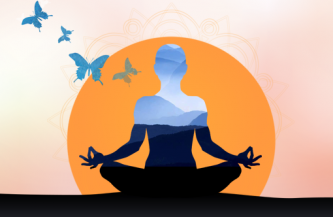YOGA & MENTAL HEALTH IN SENIOR CITIZENS

INTRODUCTION
Yoga is a classical Indian form that creates a dynamic connectivity between body, mind and soul. One can start learning this art at any age; in fact experts believe Yoga helps one age better and improves flexibility and strength of the body through simple and uncomplicated practices as well as to stay physically fit, mentally alert, and enhance spirituality. The qualitative aspect of health is considered important in Yoga and other Indian systems of medicine. Geriatrics is termed as Rasayanatantra according to Ayurveda and anti ageing therapy is called Rasayana chikitsa which is closely related to Yoga Therapy. Many health concerns in senior citizens have been linked to the sedentary lifestyle and inactivity leads to muscular shortening, tightening and weakening. Lack of movement leads to joint deterioration and loss of flexibility.
According to a fact sheet of the World Health Organization (WHO), mental health includes “subjective well-being, perceived self-efficacy, autonomy, competence, inter-generational dependence, and self-actualization of one’s intellectual and emotional potential, among others. It further states that the well-being of an individual is encompassed in the realization of their abilities, coping with normal stresses of life, productive work and contribution to their community. Cultural differences, subjective assessments, and competing professional theories all affect how “mental health” is defined. A widely accepted definition of health by psychoanalyst Sigmund Freud: the capacity “to work and to love” is considered to be simple accurate definition of mental health’.

VIEWS FROM THE TRADITIONAL ANGLE
The Yogic concept of health and disease (as explained in Yoga Vasishtha) enables us to understand that the cause of physical disorder sprouts from the higher levels of the mind and beyond. Adhi – the disturbed mind is the cause and Vyadhi – the disease which is the effect manifested in the physical body.
Maharishi Patanjali mentions “Vyadhi” as a hindrance to the complete integration of the individual personality. He doesn’t directly refer to the treatment of particular diseases as his approach is more holistic and expanded rather than analytical and limited.
Any sign of disease manifested in the body is a result of a mental imbalance or an unhealthy attitude. Srimad Bhagavad Gita defines yoga as equanimity at all levels which may also be taken as the perfect state of health where there is physical homeostasis and mental equanimity giving rise to a healthy harmony between the body and mind.
An old man complained to Buddha; “I am an old one; suffering from several disorders. I am unhappy.” Buddha advised him; “even if your body is ill, let your mind not be ill.”

YOGA AS THERAPY
Growing old is when you have leisure time for your own self, for recreation (Vihar), to pursue with the hobbies and interests in life as well as for relaxation. Ageing is an inevitable natural process associated with sluggish metabolism, demineralization of bone and decreased energy levels, feeling of weakness and decrease in power of resistance. Common complaints of arthritis, incontinence, insomnia, difficulty in breathing, bronchitis, prostate enlargement, high blood pressure, diabetes etc coupled with mental depression, loneliness, anxiety, suspicion, self-centeredness, low self-esteem due to wear and tear of the brain tissues. This raises the need for the seniors to stay fit and healthy during this age, though degeneration of the body also set some limits to the types of exercises they can do.
Swami Gitananda Giri states, “Yoga is the science and art of right-useness of body, emotions and mind”. Yoga is concerned more with the mind than the body. Any sign of disease manifested in the body is a result of a mental imbalance or an unhealthy attitude. Yoga has proven to be immensely therapeutic, in preventing the deterioration through ageing. As one grows older the transformation back into the childhood begins. Feeling sad, lonely, worried, or bored may be more common for older people; facing retirement or coping with the death of a spouse, relative, or friend. Adapting to these changes leaves them feeling lonely. They carry a notion that they are of no use anymore to the family or the society and hence start feeling inferior and depressed. The physical mobility, range of movement, flexibility decreases as on ages and physical stiffness radiates to their mind too. Hence, before starting over the practice sessions for the seniors, it is very vital to talk to them on a personal one-to-one basis. Yogic Counselling is the first and foremost step before starting the Yogic curriculum.

YOGA FOR THE SENIOR CITIZENS
Yoga has been proved to help alleviate or reduce many of the health challenges, making it an increasingly popular choice for the older adult population. Among the many benefits of Yoga, it has been shown to slow or even slowly reverse the ageing process. This is undoubtedly the major underlying principle that this traditional practice survives and flourishes all over the world. Any form of group activity, be it Yoga or otherwise, is mood-elevating for seniors. The social aspect of attending a group practice is invaluable. The contact group provides a sense of belonging driving the loneliness away.
Yogic practices aim at maintaining and improving the various motor skills. Simple warming up practices, the Jathis and Kriyas is essential to induce the flexibility.
Asanas, the isometric passive stretching practices in Yoga are non-strenuous, non-fatiguing and can be performed comfortably even at an advanced age. Talasana, Katichakrasana, Ardhakatichakrasana and Trikonasana stretch and twist giving an excellent effect of traction. Asanas like Mehruasana and Padahastasana help normalize blood pressure by resetting the baro-reflex sensitivity. Vajrasana, Sukhasana ,Paschimotanasana, Purvottanasana, Vakrasana, ArdhaMatsyendrasana, Navasana, Matsyasana, Makarasana ,Bhujangasana, Ardhashalabhasana , Ekapadauttanasana Dwipadauttanasana , Pavanamukthasana also have a tremendous effect on normalizing the various physiological functions. The shortened muscles are stretched gradually and pain in joints is reduced thus relieving a general complaint found in the elderly. Asanas build up proper tone in the muscles while the function of the vital organs is also improved simultaneously.

Controlled breathing in Pranayama helps in adjusting the circulatory-respiratory complex of the body towards normal activity. Some of the practices recommended are Mukhabhastrika Pranayama, Chandranadi Pranayama, Nadi Shuddhi, Pranava Pranayama, Bhramari Pranayama, Sukha Purvaka Pranayama and the Savitri Pranayama. These practices improve the flow of the life force (Prana), open energy channels, thus harmonizing functions of the body-mind-emotion complex with increased awareness. It also calms and relaxes the mind, alleviates mood and creates healthy attitudes resulting in emotional stability.
Purificatory processes of Yoga called Shat Kriyas are helpful in removing the imbalance in the various secretions of the body. They also help in balancing the Tridoshas (Vata, Pitta and Kapha), the three humors of the body. Kriyas like Neti help improve the immunity reducing the chances of infectious attacks.
Mudras and Bandhas are the psychic, emotional, devotional gestures. They are attitudes of energy flow. Practices like Brahma Mudra working with breath and sound vibration induces a sense of relaxation and reinvigorates the head and neck region which reduces stress, Viparita Karani Mudra (the topsy turvy pose that has an excellent effect on the psycho-neuro-immuno-endocrine normalization) Shanmuki Mudra, Ashwini Mudra, Moola Bandha and Jalandhara Bandha may be given to them. Regular practice calms and stabilizes the mind, and also directs the flow of Prana to the heart, lungs and brain. This in turn improves vitality of all organs and drives away depression, producing a great sense of joy and happiness.
The practice of Dhyana (meditation), reduces the feeling of loneliness and gives peace of mind. Directing attention consciously to the different parts of the body during meditation helps increase the blood flow and channelize energy to those parts. (Yatho mana;Tatho Prana – Where the mind goes, there the Prana flows)
Yogic relaxation techniques like Spanda Nishpanda ,Kaya Kriya in Shavasana and Marmanasthanam Kriya helps rejuvenate the body and mind creating a sense of awareness and relaxation.
CONCLUSION
Whatever activity one is engaged in- be it Yoga or any other form, should provide contentment, satisfaction and self confidence, must help maintain a youthful mind, cultivate flexibility, strengthen the immune system, nourish the body, and much more. As one begins to reverse the biological age, tapping into the inner reservoirs of unlimited energy, creativity, and vitality becomes easy and natural, improving the sense of well-being. Yoga certainly helps change the habits of thinking and behaving and alter the experience of the body and the ageing process. Old age can be made not only bearable but also pleasurable. After all, old age is not a matter of years but a condition of mind and Yoga brings a healthy state of mind. Yoga aims at enabling the individual to attain and maintain the “Sukhasthanam” (the natural state of the being), enables one to attain the sense of physical, mental and spiritual wellbeing. Yoga may not only add a few years to life but also may add life to the years. Therefore, practice of Yoga should become an integral part of old age.





